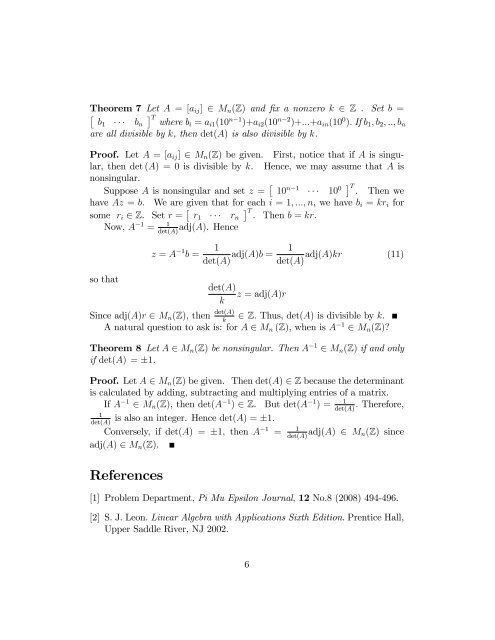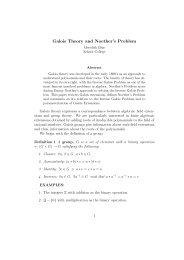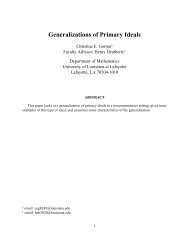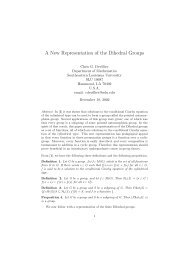Divisibility of the Determinant of a Class of Matrices ... - MAA Sections
Divisibility of the Determinant of a Class of Matrices ... - MAA Sections
Divisibility of the Determinant of a Class of Matrices ... - MAA Sections
Create successful ePaper yourself
Turn your PDF publications into a flip-book with our unique Google optimized e-Paper software.
Theorem 7 Let A = [a ij ] ∈ M n (Z) and fix a nonzero k ∈ Z . Set b =<br />
<br />
b1 · · · b n<br />
T<br />
where bi = a i1 (10 n−1 )+a i2 (10 n−2 )+...+a in (10 0 ). If b 1 , b 2 , .., b n<br />
are all divisible by k, <strong>the</strong>n det(A) is also divisible by k.<br />
Pro<strong>of</strong>. Let A = [a ij ] ∈ M n (Z) be given. First, notice that if A is singular,<br />
<strong>the</strong>n det (A) = 0 is divisible by k. Hence, we may assume that A is<br />
nonsingular.<br />
Suppose A is nonsingular and set z = 10 n−1 · · · 10 0 T<br />
. Then we<br />
have Az = b. We are given that for each i = 1, ..., n, we have b i = kr i for<br />
some r i ∈ Z. Set r = T<br />
r 1 · · · r n . Then b = kr.<br />
Now, A −1 = 1 adj(A). Hence<br />
det(A)<br />
so that<br />
z = A −1 b =<br />
1<br />
det(A) adj(A)b = 1<br />
adj(A)kr (11)<br />
det(A)<br />
det(A)<br />
z = adj(A)r<br />
k<br />
Since adj(A)r ∈ M n (Z), <strong>the</strong>n det(A)<br />
k<br />
∈ Z. Thus, det(A) is divisible by k.<br />
A natural question to ask is: for A ∈ M n (Z), when is A −1 ∈ M n (Z)?<br />
Theorem 8 Let A ∈ M n (Z) be nonsingular. Then A −1 ∈ M n (Z) if and only<br />
if det(A) = ±1.<br />
Pro<strong>of</strong>. Let A ∈ M n (Z) be given. Then det(A) ∈ Z because <strong>the</strong> determinant<br />
is calculated by adding, subtracting and multiplying entries <strong>of</strong> a matrix.<br />
If A −1 ∈ M n (Z), <strong>the</strong>n det(A −1 ) ∈ Z. But det(A −1 ) = 1 . Therefore,<br />
det(A)<br />
1<br />
det(A)<br />
is also an integer. Hence det(A) = ±1.<br />
Conversely, if det(A) = ±1, <strong>the</strong>n A −1 = 1 adj(A) ∈ M det(A) n(Z) since<br />
adj(A) ∈ M n (Z).<br />
References<br />
[1] Problem Department, Pi Mu Epsilon Journal, 12 No.8 (2008) 494-496.<br />
[2] S. J. Leon. Linear Algebra with Applications Sixth Edition. Prentice Hall,<br />
Upper Saddle River, NJ 2002.<br />
6

















